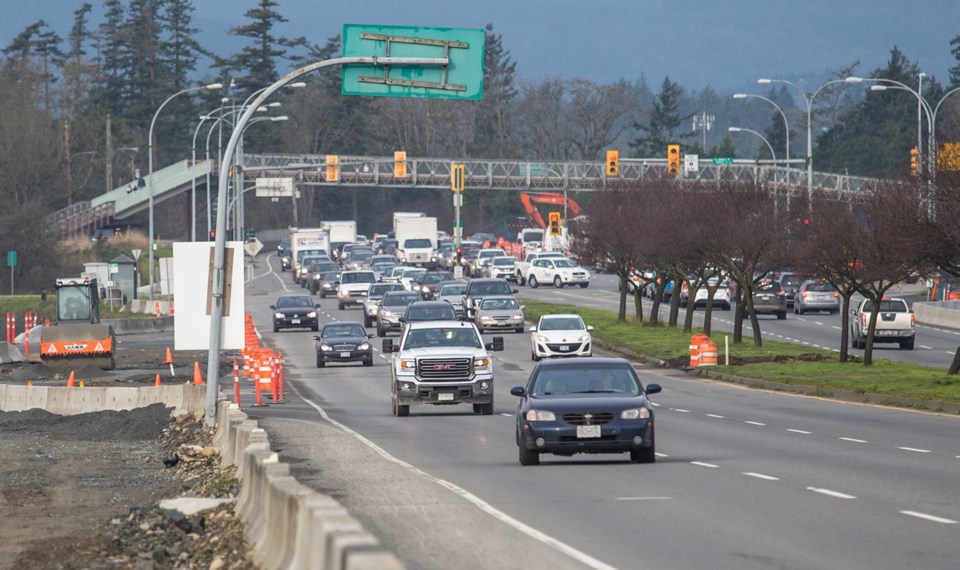Colwood Mayor Rob Martin believes the Colwood Crawl is a misnomer and, instead, the McKenzie interchange “pinch point” causes traffic jams, because several major routes converge at McKenzie.
So Martin is proposing a sea bus to move commuters from Royal Bay to downtown Victoria. He plans to meet government officials to discuss the idea.
At least Martin is thinking about solutions. The head-in-the-sand, or perhaps concrete, attitude of regional mayors and MLAs is frustrating. While local municipalities have been on a building tear, adding people and vehicles, there have been few solid solutions to move the growing masses.
Each weekday, as I leave my Otter Point home for the 43-kilometre commute to downtown Victoria, I thank God I’m on the road at 5 a.m. Instead of a 90-minute or more drive downtown, I can make it in 50 minutes, barring a slowpoke driving below the speed limit, who doesn’t have the good manners or common sense to pull over and let others pass.
My drive home, about 2 p.m. on weekdays, is frustrating, but I do better than those who are on the road later in the afternoon when a two-hour commute is becoming common. Think of the costs of lost productivity, excessive fuel being burned, stress on vehicle components, not to mention the stress on people trying to supply a service or product such as tradespeople, couriers and transit.
Now that I’ve travelled for 21Ú2 years through Otter Point, Sooke, Metchosin, Langford, Colwood, View Royal, Esquimalt and finally Victoria, I have to disagree with Martin regarding the Colwood Crawl. Thanks to poorly timed lights and smart signals that are triggered by approaching vehicles, traffic begins to back up in Colwood at the intersection of Sooke and Kelly roads, where a couple of vehicles can force dozens to stop. The jam thickens at the Royal Road lights, intensifies at the Goldstream intersection and then balloons at the Wale Road/Ocean Boulevard junction. Add the few lights-for-convenience at the casino and Hart Road and voila, traffic is crawling.
Much better would be to vastly curtail green-light time for several of the minor feeder streets, such as Kelly, Goldstream, Wilfert and Hart, and keep lights green longer for Victoria-bound Sooke Road traffic during the morning rush hour, which is now from about 6 a.m. to 9:30 a.m.
Kevin Balke, an engineer at the Texas Transportation Institute at Texas A&M University, told me that traffic lights should be timed for peak periods and favour the major streets, which means feeder streets are much less of a priority.
As well, dynamic traffic-light controls, which are successive lights that are synchronized to allow a string of traffic to travel without stopping, should be in place. I could be wrong, but it doesn’t appear Greater Victoria makes much use of the technology. Who else has gone through a green light in downtown Victoria or Langford, only to be stopped a block away?
We know traffic lights can make a difference. In early November, during another McKenzie snafu, after the traffic light for southbound Trans-Canada Highway traffic was green for 15 seconds longer, traffic cleared 30 minutes earlier than in the previous two days. As Janelle Staite, a Ministry of Transportation director, told me this year, traffic lights on the Trans-Canada Highway are controlled to diminish slowdowns. It’s common sense that traffic heading into Victoria during the morning rush should face long green lights to eliminate the stops that lead to congestion, with the green-light controls being reversed for supper-time traffic.
Still, the use of traffic lights to keep traffic moving, while paved with good intentions, is not the ultimate fix.
“There comes a point that no matter what you do, you can’t crank more cars through. At some point, you have to build more capacity,” Balke said.
Not just for vehicles, but for pedestrians and cyclists. Greater Victoria’s elected officials need to unite and find solutions that embrace all residents, not solely their constituents. Until then, will they see the light?
Shannon Moneo lives in Otter Point.



